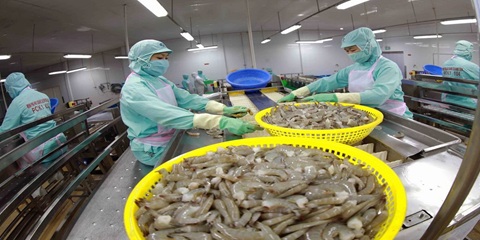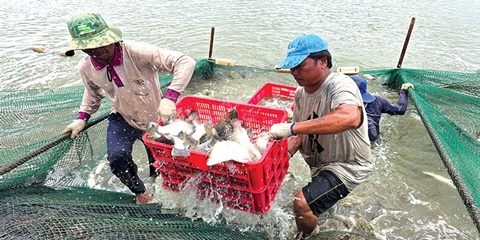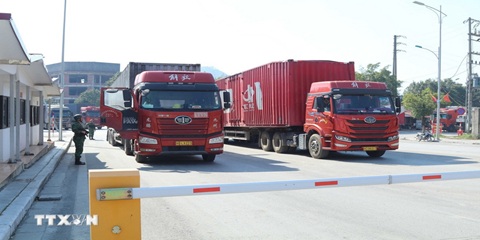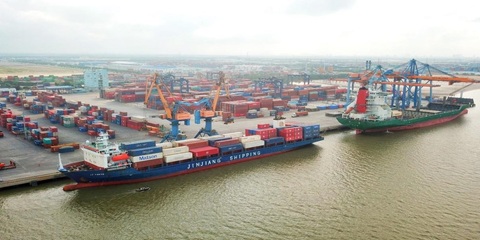Want to be in the loop?
subscribe to
our notification
Business News
TEXTILE, FOOTWEAR COMPANIES CONFIDENT THEY CAN COPE WITH THIS COVID-19 WAVE TOO
Armed with experience from coping with the first wave of the COVID-19 epidemic, many textile and footwear enterprises are quietly confident they can alter their plans as required and find new markets to cope with the second.
The situation is worsening, according to most companies in the two sectors as the epidemic returns to Việt Nam and continues to rage in many countries around the world.
Lê Tiến Trường, general director of the Việt Nam National Textile and Garment Group, said that in the first six months of the year, though affected a great deal by the COVID-19 pandemic, his company sustained its operations and cash flows thanks to its decision to produce face masks and personal protective equipment (PPE).
But the situation would be very different in the second half since the demand for those products is shrinking rapidly, he said.
The fact that many manufacturers switched to producing PPE has seen supply shoot past demand, he added.
Since the global outbreak began in April, many Vietnamese garment and textile businesses have been told by their US and EU partners that they would temporarily stop taking delivery of goods.
Phạm Xuân Hồng, chairman of the HCM City Association of Garment Textile Embroidery and Knitting, said this was because governments in the US and EU have declared a state of emergency and tightened border controls due to the rapid spread of COVID-19.
“They have asked Vietnamese businesses to suspend delivery, including of those en route, until borders are reopened.”
He said the US and EU are two important textile export markets for the country, while half of all exports from HCM City go to the US and 15-18 per cent to the EU.
“Partners in these markets have announced the suspension of deliveries, meaning the market for textiles and garments has narrowed by nearly two-thirds.”
Trường said developing the domestic market is the most feasible way to survive the pandemic.
Though the domestic market accounts for only 10 per cent of the industry’s capacity and cannot fully mitigate the unemployment problem, it is still a solution, he said.
Support from the Government in the form of access to cheap credit and deferred tax payment is also imperative, he said.
Phan Thị Thanh Xuân, general secretary of the Việt Nam Leather, Footwear and Handbag Association (LEFASO), too said though the domestic market is very small, developing it would be a key solution amid the difficulties in exporting.
"The domestic market cannot replace the US and European markets, but for the moment it is good if producers can sell products somewhere.”
Nguyễn Văn Miêng, general director of the Nam Định Textile and Garment Corporation, said companies have restructured their markets to sustain jobs. In the past, his company produced 1,100 tonnes of yarn and exported 65 per cent of it, but has now cut it to 45 per cent.
It produces around 1.2 million metres of fabric per month, but this is likely to decrease to 23,000-300,000 metres in the last two quarters of the year, he said.
The company is seeking to expand its market for new products in the north and taking advantage of dyed fabrics to sell finished products and supply to garment companies, he said.
It also wants to strengthen the yarn - weaving - dyeing links so that all companies in the chain could benefit, he added.
Wait for EVFTA
The EU-Việt Nam Free Trade Agreement (EVFTA) that took effect on August 1 will reduce import taxes on Việt Nam's garment exports by more than 70 percentage points.
Vietnamese footwear and textile and apparel enterprises will benefit significantly from the EVFTA because of the tariff cuts, according to Bảo Việt Securities Joint Stock Company.
With most other countries that export textile and garments to the EU not having a trade deal with the bloc, the EVFTA would open a great opportunity for Việt Nam’s footwear, textile and garment exports if companies enterprises meet origin requirements, it added.
Source: VNS
Related News

VIETNAM’S SEAFOOD EXPORTS HIT OVER US$10 BILLION IN JAN-NOV
Seafood export revenue in November alone amounted to nearly US$990 million, up 6.6% year-on-year. Key product groups posted solid gains. Shrimp exports rose 11.7% to over US$385 million, supported by strong demand for whiteleg shrimp and lobster. Tra fish shipments increased 9.7% to almost US$197 million, while marine fish, squid, and mollusk exports maintained their recovery.

VIETNAM’S AGRO-FORESTRY-FISHERY EXPORTS HIT NEW RECORD IN JAN-NOV
Vietnam’s agro-forestry-fishery export revenue reached an estimated US$64.01 billion in the first 11 months of 2025, up 12.6% year-on-year and surpassing the full-year record of US$62.4 billion set in 2024. Agricultural exports reached US$34.24 billion, up 15% year-on-year, while livestock products brought in US$567.4 million, a 16.8% increase. Seafood exports rose 13.2% to US$10.38 billion, and forestry products earned US$16.61 billion, up 5.9%.

HANOI REPORTS RECORD-HIGH BUDGET REVENUE IN 2025
Hanoi’s budget revenue is estimated to reach VND641.7 trillion in 2025, the highest level ever recorded and nearly 25% above the revised target, according to a report by the municipal government. Data from the city’s socioeconomic performance review shows that total state budget collections in 2025 are projected to reach 124.9% of the adjusted plan and rise 24.9% from 2024, the Vietnam News Agency reported.

VIETNAM, CHINA TO PILOT TWO-WAY CARGO TRANSPORT AT LANG SON BORDER
Vietnam and China will launch a one-year pilot program on December 10 to allow two-way cargo transport through the Huu Nghi–Youyi Guan international border gates in Lang Son Province, reported the Vietnam News Agency. The Dong Dang-Lang Son Economic Zone Management Board said the trial aims to reduce transport costs and improve customs clearance capacity.

VIETNAM’S IMPORT-EXPORT VALUE NEARS US$840 BILLION IN JAN-NOV
The total value of Vietnam’s imports and exports was nearly US$840 billion between January and November this year, the highest level ever recorded, according to the National Statistics Office. In its latest report on the country’s socio-economic performance, the National Statistics Office highlighted a series of positive economic indicators, with trade emerging as one of the strongest drivers of growth.

OVER 19 MILLION INTERNATIONAL VISITORS COME TO VIETNAM IN JAN-NOV
Vietnam received more than 19.1 million international visitors in the first 11 months of 2025, a 20.9% increase year-on-year and the highest level ever recorded, according to the National Statistics Office. The figure surpasses the full-year record of 18 million arrivals set in 2019, before the Covid-19 pandemic. Nearly two million foreign visitors arrived in November alone, up 14.2% from October and 15.6% from the same period last year.
























